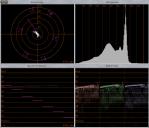
-
Does anyone know if this is a world (PAL/NTSC switchable) camera?
-
@sgreszcz: No, it annoyingly isn't, you can read about it in the manual linked earlier in this thread. The only thing switchable between PAL and NTSC typical frequencies is the TV replay output.
And sure enough, there is no technical reason for this restriction, it's just the ugly face of corporations fighting globalisation on their "sell" side (while they sure want all the benefits from buying global).
-
Some shops in Germany now claim to have LX100 available in stock.
I wonder whether I should get one before there's an underwater housing available, I might be inclined to make that gamble.
In other news, there's yet another review from pocket-lint.com, but it certainly wasn't written by geniouses given there are statements in this review like "We are unable to look at the raw files as the provided SilkyPix software is not yet compatible with the LX100." - d'oh!
-
First review with 4k video samples for download from vimeo:
http://www.cameralabs.com/reviews/Panasonic_Lumix_LX100/
The flat version looks good:
scope, no clipping:

 scope.jpg632 x 543 - 123K
scope.jpg632 x 543 - 123K -
A bit out of topic (and kinda noob) question: I've always downloaded 4k original files from reviews when available, and always played smoothly in my machine (Core i5 2500k, 16 gb ram, GTX 750ti); but yesterday I've downloaded the samples from ePhotozine and the video stuttered a lot; Windows Media Player and VLC, both with the same stuttered results. Anybody knows if Nvidia modified something in the video drivers (updated it to the last release yesterday), or some new codec needed?
-
Comparison with other large sensor compacts


 chart35.jpg800 x 533 - 46K
chart35.jpg800 x 533 - 46K -
Grabbed one last night. It should ship out today, may have it as early as tomorrow. Let me know if you guys have any questions regarding operation/performance. Will you be starting a separate review thread, VK?
-
@Tron, for me, I would like confirmation about the issues that the Cameralabs (http://www.cameralabs.com/reviews/Panasonic_Lumix_LX100/) test had raised:
- Moiré (checking in both in 4k and 1080p);
- No filter thread in the lens? (needed to use ND filters);
- OIS performance (I guess that the micro-jitter problems from the newer Panny lens are present).
-
Marcio,
I've read repeatedly that it has a 43mm thread.
-
@TwitHerb I've heard it too, but in the review above they say:
"There's also no filter thread on the LX100, nor an optional accessory for mounting them, although there is a bayonet for the optional auto lens cap that suggests it could be possible in the future or via a third-party."
-
Wow, that's kinda weird that they would have removed it...
I guess some like P&C could offer this in 43mm: http://www.photographyandcinema.com/collections/lens-accessories/products/magfilter-threaded-adapter-ring
-
@MarcioK I'm curious about these myself. I had not heard about the lack of threads on the lens, they are listed in the official spec as 43mm. If the moire is present it could be indicative of a weaker low pass filter than what the GH4 uses (though I have also experienced minor moire on the GH4). I'll try and shoot some fine mesh material to see how it behaves once I receive it.
-
If there is no filter thread, then why does the LX100 manual say "Lens (Filter diameter Φ43 mm)"? A cruel joke?
-
I've found the filter thread absence somewhat strange too, and I think that maybe there is some kind of cover not perceived in the review - hence the ask to @tron confirm this.
About the moire, in the review they stated that the reason is because Panasonic is not using a 1:1 crop in the sensor:
It's also worth looking at how Panasonic generates both 1080 and 4k video. When filming 1080, the LX100 takes the full usable sensor width of 4480 pixels and scales it down to 1920 pixels. So the diagonal field of view when filming in 1080 is identical to shooting 16:9 stills, but of course the uneven scaling factor means there's also artefacts to deal with. So far so similar to the GH4 and FZ1000, but the LX100 handles 4k differently. On the GH4, the 4k modes simply took 3840x2160 or 4096x2160 crops direct from the middle of the sensor and recorded them without scaling. Since they were crops, there was a reduction in the field of view, but since there was no scaling, there was also no moire to worry about. On the FZ1000 the sensor resolution was higher than the GH4, so a 1:1 crop would have resulted in an even greater field of view reduction. So I believe Panasonic took a milder crop and scaled it down. Since the LX100 already crops its 16 Megapixel sensor to 11.1 Megapixels for 16:9 stills, it has the potential for a 1:1 4k crop with the least field-reduction of the three cameras. After all, 16:9 stills on the LX100 measure 4480 pixels wide compared to 4608 pixels on the GH4. So making a UHD crop measuring 3840 pixels wide on the LX100 would only reduce the field of view by 1.17 times. So instead of 24mm at the widest zoom, you'd be looking at 28mm. But bizarrely Panasonic has opted to employ a mild crop and a scale to generate the desired frame size. This means the LX100's 4k footage not only has a slightly narrower field of view to 1080 video and 16:9 stills (so instead of 24mm at the widest zoom, you're getting 26mm), but it also now suffers from moire. I feel it's an unnecessary compromise too, since a nice clean 1:1 crop would have only involved losing 4mm in the diagonal field of view. I put my disappointment to Panasonic and I got the impression the scaling along with absence of Cinelike D profiles was partly for the LX100's target audience and partly to protect the GH4, but I still think a 1:1 crop would have been better, and rather than detract from GH4 sales, I could see existing GH4 owners picking up an LX100 as a B-roll camera. Maybe flat profiles and 1:1 video crops will be offered in future third-party firmware. -
@MarcioK I disagree with his assumptions on the 4K scaling. This is not an oversized sensor used with a standard m43 image circle, but rather a lens circle concentrated inside of a standard 4/3 sensor. The effective crop for 4K should actually be 2.17x on the LX100. This is calculated by dividing the FF equivalent wide angle from 4K mode (26mm) by the 12mm simulated wide angle from photo mode (which is actually 10.9mm due to the smaller image circle from the lens). Comparatively, the GH4 is closer to 2.4x crop in 4K mode hence the disparity.
-

I needed a shutter speed of 1/60 to successfully handhold a sharp image without shake when stabilisation was turned off. With stabilisation enabled, I could achieve a similar result at 1/15, corresponding to around two stops of compensation. Not only is this below the usual three or even four stops I can normally expect from a Panasonic optical stabilisation system, but the difference between stabilised and unstabilised stills wasn't great either. This performance extended into video too, with the LX100 delivering fairly lacklustre compensation against wobbles. I'm somewhat perplexed by this as Panasonic normally has a fantastic track record for optical stabilisation, and as far as I understand, my test sample was a final production model.

 sigma_19.jpg800 x 532 - 43K
sigma_19.jpg800 x 532 - 43K -

 sigma_20.jpg800 x 604 - 114K
sigma_20.jpg800 x 604 - 114K -
@MarcioK: Just received my lx100. Definitely has the filter threads.
And I have a hard time playing back 4K video on my old computer but moire seems pretty well taken care of on my first few tries

 lx100_threads.jpg3264 x 2448 - 503K
lx100_threads.jpg3264 x 2448 - 503K -
@rigg4d Thanks. :)
-
One thing you can't reproach the Lumix LX100 for is not having enough file formats to record video in. It does 4K in 24p and 25p at 100 Mbps (although it's actually Ultra HD 3840 x 2160, not 4K 4096 x 2160), HDTV in 50p and 25p, all in MP4, plus HDTV in 50p, 50i, 25p and 24p in AVCHD. There's even a "Photo 4K" mode that's optimized for extracting 8 Mpx stills from 4K videos. As on the GH4 and FZ1000, when you record in 4K the maximum wide-angle is reduced from 24mm to 26mm
As expected, the picture and sound quality are top-notch at all times: there's no flickering, no audio saturation and the image is ultra-sharp and well-defined. You can adjust the aperture, shutter speed and ISO sensitivity, plus there's exposure compensation, focus peaking and zebra patterning. The LX100 does everything. All that's missing is a microphone jack and a headphone jack—no possibility to attach external ones on the hot shoe, either. Is that a shame? Maybe, but ultimately the LX100 is more like a high-quality video notepad than a dedicated video camera anyway.
http://www.digitalversus.com/digital-camera/panasonic-lumix-lx100-p21696/test.html
Howdy, Stranger!
It looks like you're new here. If you want to get involved, click one of these buttons!
Categories
- Topics List23,985
- Blog5,725
- General and News1,353
- Hacks and Patches1,152
- ↳ Top Settings33
- ↳ Beginners255
- ↳ Archives402
- ↳ Hacks News and Development56
- Cameras2,363
- ↳ Panasonic993
- ↳ Canon118
- ↳ Sony156
- ↳ Nikon96
- ↳ Pentax and Samsung70
- ↳ Olympus and Fujifilm100
- ↳ Compacts and Camcorders300
- ↳ Smartphones for video97
- ↳ Pro Video Cameras191
- ↳ BlackMagic and other raw cameras115
- Skill1,960
- ↳ Business and distribution66
- ↳ Preparation, scripts and legal38
- ↳ Art149
- ↳ Import, Convert, Exporting291
- ↳ Editors191
- ↳ Effects and stunts115
- ↳ Color grading197
- ↳ Sound and Music280
- ↳ Lighting96
- ↳ Software and storage tips266
- Gear5,420
- ↳ Filters, Adapters, Matte boxes344
- ↳ Lenses1,582
- ↳ Follow focus and gears93
- ↳ Sound499
- ↳ Lighting gear314
- ↳ Camera movement230
- ↳ Gimbals and copters302
- ↳ Rigs and related stuff273
- ↳ Power solutions83
- ↳ Monitors and viewfinders340
- ↳ Tripods and fluid heads139
- ↳ Storage286
- ↳ Computers and studio gear560
- ↳ VR and 3D248
- Showcase1,859
- Marketplace2,834
- Offtopic1,319
Tags in Topic
- panasonic 578









